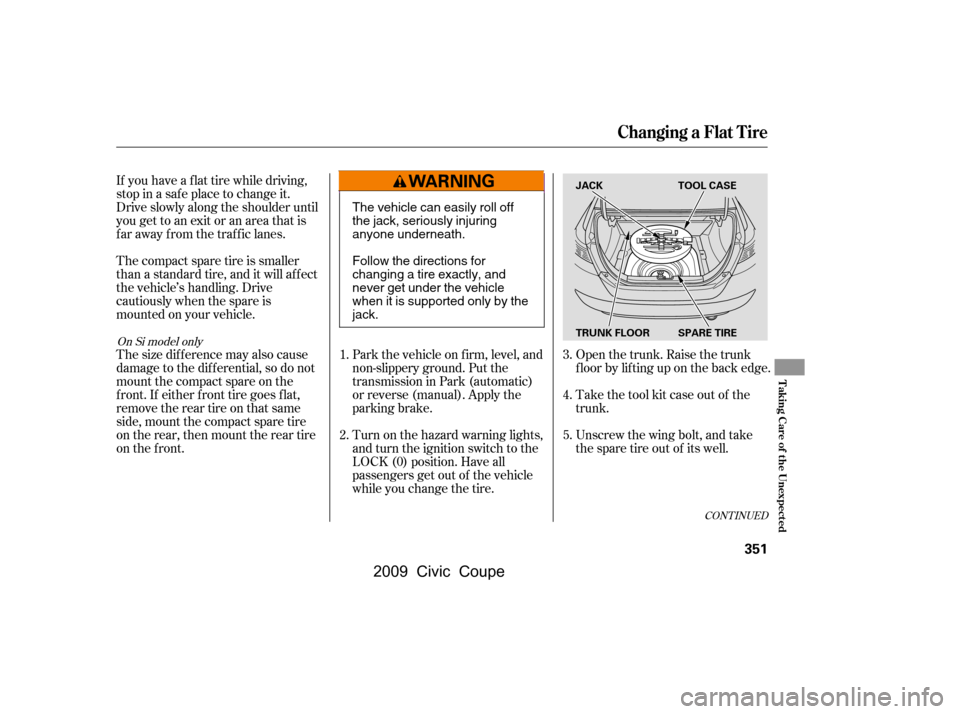Page 346 of 412

Mount tire chains on your tires when
required by driving conditions or
local laws. Install them only on the
f ront tires.
If you mount snow tires on your
vehicle, make sure they are radial
tires of the same size and load range
as original tires. Mount snow tires on
all f our wheels. The traction
provided by snow tires on dry roads
maybelowerthanyouroriginaltires.
Check with the tire dealer f or
maximum speed recommendations. When installing chains, f ollow the
manuf acturer’s instructions, and
mount them as tight as you can.
Make sure they are not contacting
the brake lines or suspension. Drive
slowly with them installed. If you
hear them coming into contact with
the body or chassis, stop and
investigate. Remove them as soon as
youbegindrivingonclearedroads.Because your vehicle has limited tire
clearance, Honda strongly
recommends using the chains listed
below, made by Security Chain
Company (SCC).
Cable-type: SCC Radial Chain
DX, Canadian DX-G
LX,EX,EX-L,Si
Cable-type: SCC Radial Chain
CONT INUED
Tires
T ire Chains
Snow T ires
Maint enance
343
SC1030
SC1032
�\f���—�\f���—�\f���y�
�
����
��\f���y���
�(�+�������\f�y�\f�������y
2009 Civic Coupe
Page 347 of 412
Clean the wheels as you would the
rest of the exterior. Wash them with
thesamesolution,andrinsethem
thoroughly.
Aluminum alloy wheels have a
protective clear-coat that keeps the
aluminum f rom corroding and
tarnishing. Cleaning the wheels with
harsh chemicals (including some
commercial wheel cleaners) or a stif f
brush can damage the clear-coat. To
clean the wheels, use a mild
detergent and a sof t brush or sponge.
If equipped
Wheels
Tires
344
Using the wrong chains, or not
properly installing chains, can
damage the brake lines and
cause a crash in which you can
be seriously injured or killed.
Follow all instructions in this
owner’s manual regarding the
selection and use of tire chains.
Traction devices that are the wrong
size or improperly installed can
damage your vehicle’s brake lines,
suspension, body, and wheels. Stop
driving if they are hitting any part of
the vehicle.
�\f���—�\f���—�\f���y�
�
����
��\f���y���
�(�+�������\f�y�\f�������y
2009 Civic Coupe
Page 350 of 412

If you need to park your vehicle f or
an extended period (more than 1
month), there are several things you
should do to prepare it f or storage.
Proper preparation helps prevent
deterioration and makes it easier to
get your vehicle back on the road. If
possible, store your vehicle indoors.Fill the f uel tank. Block the rear wheels.
If the vehicle is to be stored f or a
longer period, it should be
supported on jackstands so the
tires are of f the ground.
Cover the vehicle with a
‘‘breathable’’ cover, one made
f rom a porous material such as
cotton. Non-porous materials, such
as plastic sheeting, trap moisture,
which can damage the paint.
Leave one window open slightly (if
the vehicle is being stored
indoors). If possible, periodically run the
engine until it reaches f ull
operating temperature (the
cooling f ans cycle on and of f
twice). Pref erably, do this once a
month.
To minimize sticking, apply a
silicone spray lubricant to all door
and trunk seals. Also, apply a
vehiclebodywaxtothepainted
surfaces that mate with the door
and trunk seals.
Support the f ront wiper blade
arms with a f olded towel or rag so
they do not touch the windshield.
Disconnect the battery.
Wash and dry the exterior
completely.
Cleantheinterior.Makesurethe
carpeting, floor mats, etc., are
completely dry.
Leave the parking brake off. Put
the transmission in reverse
(manual) or Park (automatic).
Vehicle Storage
Maint enance
347
�\f���—�\f���—�\f���y�
�
����
����
�y���
�(�+�������\f�y�\f�������y
2009 Civic Coupe
Page 352 of 412

This section covers the more
common problems that motorists
experience with their vehicles. It
gives you inf ormation about how to
safely evaluate the problem and what
to do to correct it. If the problem has
stranded you on the side of the road,
you may be able to get going again.
If not, you will also f ind instructions
on getting your vehicle towed.......................
Compact Spare Tire .350
....................
Changing a Flat Tire .351
.............
If the Engine Won’t Start .355
................................
Jump Starting .357
..............
If the Engine Overheats .359
.........
Low Oil Pressure Indicator .361
..........
Charging System Indicator .361
.......
Malf unction Indicator Lamp .362
...............
Brake System Indicator .363
..............................................
Fuses .364
..............................
Fuse Locations .368
......................
Emergency Towing .370
Taking Care of the Unexpected
T aking Care of t he Unexpect ed
349
�\f���—�\f���—�\f���y�
�
����
������y���
�(�+�������\f�y�\f�������y
2009 Civic Coupe
Page 354 of 412

CONT INUED
If you have a f lat tire while driving,
stop in a saf e place to change it.
Drive slowly along the shoulder until
you get to an exit or an area that is
far away from the traffic lanes.
Thesizedifferencemayalsocause
damage to the dif f erential, so do not
mount the compact spare on the
f ront. If either f ront tire goes f lat,
removethereartireonthatsame
side, mount the compact spare tire
on the rear, then mount the rear tire
on the f ront.
Turn on the hazard warning lights,
and turn the ignition switch to the
LOCK (0) position. Have all
passengers get out of the vehicle
while you change the tire.
Park the vehicle on f irm, level, and
non-slippery ground. Put the
transmission in Park (automatic)
or reverse (manual). Apply the
parking brake.
Open the trunk. Raise the trunk
f loor by lif ting up on the back edge.
Unscrew the wing bolt, and take
the spare tire out of its well.
Take the tool kit case out of the
trunk.
Thecompactsparetireissmaller
than a standard tire, and it will affect
the vehicle’s handling. Drive
cautiously when the spare is
mounted on your vehicle.
5.
4.
3.
2.
1.
On Si model only
Changing a Flat Tire
T aking Care of t he Unexpect ed
351
SPARE TIRETRUNK FLOOR
JACK TOOL CASE
The vehicle can easily roll off
the jack, seriously injuring
anyone underneath.
Follow the directions for
changing a tire exactly, and
never get under the vehicle
when it is supported only by the
jack.
�����—�����—�����y�
�
����
������y���
�(�+���������y���������y
2009 Civic Coupe
Page 356 of 412
CONT INUED
Bef ore mounting the spare tire,
wipe any dirt of f the mounting
surface of the wheel and hub with
a clean cloth. Wipe the hub
carefully;itmaybehotfrom
driving.
Use the extension and the wheel
nut wrench as shown to raise the
vehicle until the f lat tire is of f the
ground.
Remove the wheel nuts, then
remove the f lat tire. Handle the
wheel nuts caref ully; they may be
hot from driving. Place the flat tire
on the ground with the outside
surface facing up. Do not attempt to forcibly pry the
wheel cover of f with a screwdriver
or other tool. The wheel cover
cannot be removed without f irst
removing the wheel nuts.
11.
9.
10.DX, and U.S. LX models
Changing a Flat Tire
T aking Care of t he Unexpect ed
353
WHEEL NUTS WHEEL COVER BRAKE HUB
WHEEL NUTS
WHEEL NUT WRENCH EXTENSION
�\f���—�\f���—�\f���y�
�
�������
�
�y���
�(�+�������\f�y�\f�������y
2009 Civic Coupe
Page 360 of 412

Although this seems like a simple
procedure, you should take several
precautions.
Open the hood, and check the
physical condition of the battery.
In very cold weather, check the
condition of the electrolyte. If it
seems slushy or f rozen, do not try
jump starting until it thaws.
You cannot start your vehicle with an
automatic transmission by pushing
or pulling it.
To jump start your vehicle:
Turn of f all the electrical
accessories: heater, A/C, audio
system, lights, etc. Put the
transmission in neutral (manual)
or Park (automatic), and set the
parking brake.
The numbers in the illustrations
show you the order to connect the
jumper cables.
1.
2.
CONT INUED
Jump Starting
T aking Care of t he Unexpect ed
357
BOOSTER BATTERY
DX, Canadian DX-G, LX, EX, EX-L
A battery can explode if you do
not follow the correct procedure,
seriously injuring anyone
nearby.
Keep all sparks, open flames,
and smoking materials away
from the battery.
If a battery sits in extreme cold, the
electrolyte inside can f reeze.
Attempting to jump start with a f rozen
battery can cause it to rupture.
�����—�����—�����y�
�
�����������y���
�(�+���������y���������y
2009 Civic Coupe
Page 362 of 412

CONT INUED
Once your vehicle is running,
disconnect the negative cable f rom
your vehicle, then f rom the
booster battery. Disconnect the
positive cable f rom your vehicle,
then from the booster battery.
Keep the ends of the jumper cables
away from each other and any metal
on the vehicle until everything is
disconnected. Otherwise, you may
cause an electrical short.
If the vehicle overheats, you
should take immediate action. The
only indication may be the
temperature gauge climbing to or
above the red mark. Or you may
see steam or spray coming f rom
under the hood.
If you see steam and/or spray
coming f rom under the hood, turn
of f the engine. Wait until you see
no more signs of steam or spray,
then open the hood.
The reading of the vehicle’s
temperature gauge should stay in
the midrange. If it climbs to the red
mark, you should determine the
reason (hot day, driving up a steep
hill, etc.).
Saf ely pull to the side of the road.
Put the transmission in neutral
(manual) or Park (automatic), and
set the parking brake. Turn of f all
accessories, and turn on the
hazard warning lights.
7.
1.
2.
Jump Starting, If the Engine Overheats
If the Engine Overheats
T aking Care of t he Unexpect ed
359
Steam and spray from an
overheated engine can
seriously scald you.
Do not open the hood if steam
is coming out.
Driving with the temperature gauge
reading at the red mark can cause
serious damage to the engine.
�����—�����—�����y�
�
�����������y���
�(�+���������y���������y
2009 Civic Coupe